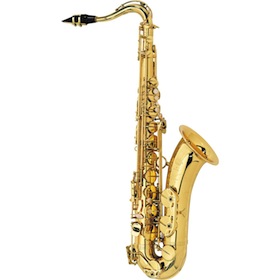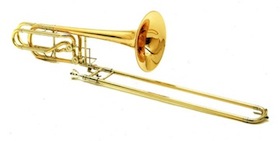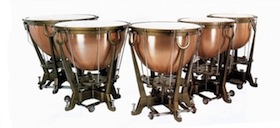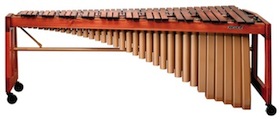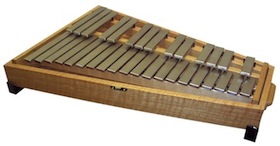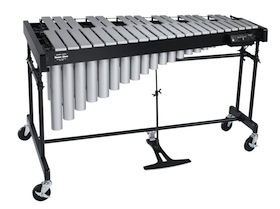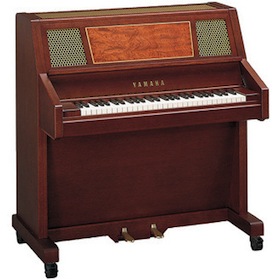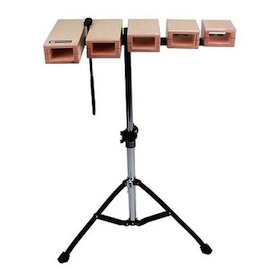Chapter 2
Musical Instruments
Throughout human history people from all parts of the world have created countless devices to make musical sounds. These devices, called instruments, have produced a wide variety of timbres or tone colors and have sounded at a wide range of pitch levels. They also have functioned in a wide variety of uses, from a simple keeping of the beat, as in the regular pounding of a stick on a log, to the soul-inspiring, transcending sound of a soaring concert violin.
This wide array of instruments is classified into four fundamental groups: Chordophones, Aerophones, Idiophones and Membranophones according to how the instruments are constructed and how they produce sound.
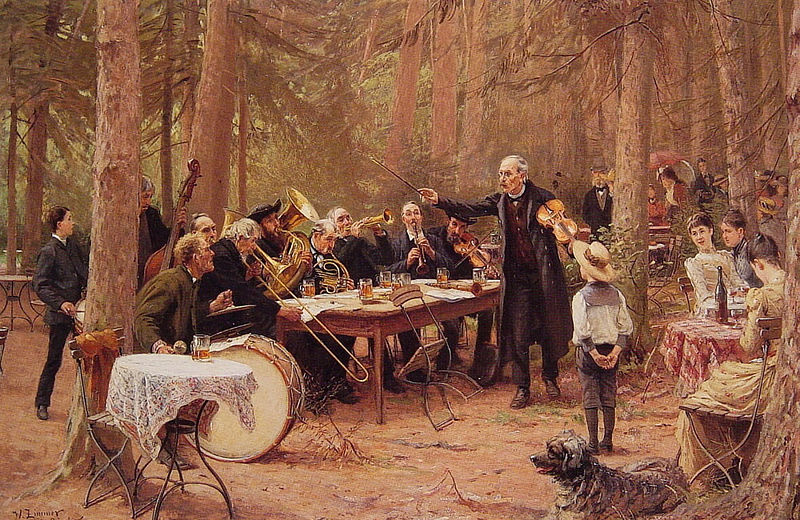
The Orchestra, Biergarten by Wilhelm Carl August Zimmer (1853-1937)
Chordophones are instruments that produce sound by plucking or drawing a
bow A shaped stick strung with many hairs which creates friction and a musical note when drawn across an instrument.
A shaped stick strung with many hairs which creates friction and a musical note when drawn across an instrument. over a wire or string made out of metal or animal material. This action causes the string to vibrate creating sound waves. The sound waves usually are amplified by being trapped in a box of some sort that is located immediately under the strings. Chordophones vary from banjos to violins and from the middle-eastern rabab to a double bass commonly used in western jazz or orchestral music.
Aerophones are instruments that produce sound by having air blown under pressure through the instrument. Sound waves usually are created in some sort of mouth piece which the player places in his/her mouth. These sound waves are amplified and take on the physical properties of the instrument as they travel through its body and out into space. We commonly think of them as wind instruments. They vary from the ancient Greek
aulos, A reed instrument common in ancient Greece
A reed instrument common in ancient Greece to a modern soprano
saxophone. A single-reed wind instrument invented in 1840 usually made of brass.
A single-reed wind instrument invented in 1840 usually made of brass.
Idiophones are instruments that have an enclosed space with something solid inside that rattles. Sound is made by the solid materials inside bouncing against the inner wall of the chamber. Bells, rattles and gourds used in ritual Indian music all belong to the idiophone group.
Membranophones are instruments that traditionally have had some sort of membrane or skin stretched tightly over a frame and which are struck. The entire family of drums belongs to this group. The timbre or tone color of drums varies according to the tightness of the stretched membrane, the material out of which the drum is made, the size of the drum and whether or not the drum is enclosed. Most membranophones produce vibrations when the surface of the instrument is struck. These vibrations pass directly into the air as sound waves without amplification. Other instruments that are struck such as
gongs, A resonating metal disc struck with a mallet. xylophones,
A resonating metal disc struck with a mallet. xylophones,  A pitched percussion instrument with wooden bars and resonator tubes.
A pitched percussion instrument with wooden bars and resonator tubes. and wooden blocks now tend to be placed in this group, too.
A fifth category must also be considered that includes all electronic instruments. Electronic instruments make sound by the opening and closing of electronic relays and switches and the replay of recorded sound. Synthesizers, computers, electronic keyboards all belong to this group.
A consistent feature of all sound producing instruments is that there must be air for the instruments to be heard. Sound does not exist in a vacuum. Once vibrations are set in motion, they must pass through air for them to be heard.
There are five common categories or families of Western musical instruments: woodwinds, brass, percussion, strings, and keyboard/electronic instruments. Instruments in each family produce sound waves in its own distinct way.
Woodwind Family
Flute
Flutes, oboes and clarinets all share approximately the same soprano range. Flutes are long cylinders, held horizontally. The player blows air through a side hole and makes vibrations with his or her lips against the hole. Originally flutes were made of wood, but now they are made of a variety of metals. It is a very agile instrument, but has a gentle, windy sound. In its high register it can be very penetrating. The piccolo is a small flute, which sounds an octave higher than the notes that are written for it to play. Alto and bass flutes also exist, but are specialty instruments. Both produce a sound like a regular flute, but lower and softer. The recorder is a flute-like instrument that is made out of wood and played by blowing through a mouthpiece at the upper end of the instrument. It produces a softer tone than that of the flute and is primarily used in renaissance and baroque music.
Oboe
The oboe is played with two reeds tied together at the end of the barrel of the instrument that produce vibrations that travel through the instrument. It is relatively short and because of the double reed produces a sound with a nasal quality, but which is extremely clear and clean with sometimes a plaintive quality. The English horn and the oboe d'amore are larger and lower sounding oboes that often play in a viola range. English horns are often used to create a pastoral effect and the use of the oboe d'amore generally is restricted to baroque music.
Clarinet
The clarinet is a slightly conical tube made of ebony. Sound is created by the player blowing on a single reed held in a mouthpiece at the top end of the instrument. This creates vibrations, which are passed through the tube. The sound quality is quite full and rich. The instrument can produce warm, lush and mellow tones as well as strident, shrill ones. The E-Flat clarinet is a small, higher pitched clarinet that is usually used when a more penetrating sound is needed. The bass clarinet is an instrument that also sounds like a clarinet, but produces very low pitches, often in depicting snakes, giants and dragons. It consists of a considerable amount of tubing, bent back and forth.
Bassoon
The bassoon is a low, cello-range instrument that generally plays the bass in ensembles. Like the oboe, it is a double reed instrument, but with a long tube bent double. It has a basically low, reedy sound, but can vary in expression from sad and plaintive to comical. The contrabassoon is a very large instrument that sounds like a bassoon, but plays an octave lower in the double bass range.
Saxophone
The saxophone is a family of instruments that spans the common instrumental pitch range. The most common saxophones are the alto and the tenor saxophone. Saxophones and clarinets produce sound in a similar way. Both are single reed instruments. But, the saxophone tube is wider and it is made of brass. This creates a mellower sound than that produced by the clarinet. The instrument also can make powerful sounds. It is sometimes used in concert ensembles or as a solo instrument in concert music, but is most frequently found in jazz.
Brass Family
Brass instruments are made of soft metal. They are the loudest of the wind instruments. All brass instruments produce sound by a player blowing into a small cup-shaped mouthpiece, making the player's lips vibrate. These vibrations are transmitted through the instrument's tubing and emerge as sound waves. The tubing of all brass instruments is very long, is coiled and is scored on the inside to facilitate vibrations
Horn
The horn is the alto member of the brass family. It has long, intricately curved tubing, valves similar to those of the trumpet and produces a lush, very mellow, romantic sound when played softly. Several French horns playing together produce a rich, luscious tone. In English, the horn is often called the "French Horn" and although it has some roots in France, the International Horn Society advocates the instrument simply be referred to as "horn."
Trumpet
The trumpet is the highest of the primary brass instruments. It has a bright, piercing, strong tone quality that often is used to create excitement in pieces. Pitch is controlled by three pistons or valves that connect or disconnect auxiliary tubes with the primary tube, and, thus, lengthen or shorten the vibrating column of air. The cornet is similar to the trumpet, but shorter in length. The bugle also is similar to a trumpet, but has no valves. The flugelhorn is another similar instrument, but is larger, plays at a different pitch level and has a darker and mellower sound.
Trombone
The trombone is also pitched lower than a trumpet. There are alto, tenor and bass trombones. In orchestras all three often are used together to make a full chorus of brass sound. A sliding mechanism rather than a valve controls pitch. Trombones are less bright than the trumpet and can produce a wide variety of sounds that range from a vocal quality in upper ranges to a blaring sound in low registers. Trombones can play very loudly.
Tuba
The tuba is the brass bass foundation instrument in orchestras. It normally plays with trombones in the orchestra and produces rich, deep bass sounds. It is less flexible than all other brass instruments and rarely plays as a solo instrument.
Percussion Family
Percussion instruments make sound when they are struck or rattled. Some percussion instruments such as gongs and most drums have no fixed pitch. Other percussion instruments like xylophones and vibraphones can play many pitches in regular scales. Percussion instruments can be divided into groups according to whether they can or cannot play fixed pitches. Pitched percussion instruments include the timpani (kettledrums), xylophone, vibraphone, marimba, glockenspiel, gongs, celesta and tubular bells or chimes. Unpitched percussion instruments include cymbals, tam-tam, triangle, wood blocks, castanets, shakers, and a wide variety of drums such as the snare drum, tenor drum and bass drum.
Pitched Percussion
Xylophones, vibraphones, marimbas, glockenspiels and celestas are instruments with either metal or wooden plates, bars or slats. Each bar is pitched and can belong to any number of scales, which allows these instruments to be used for playing melodies. The playing surface of any of these instruments is similar to that of a keyboard. Players strike the bars with mallets or hammers to make the sound. Generally these instruments are used for special effects in orchestras, but not heard consistently throughout a composition, as are the timpani. Certain jazz groups have made extensive use of the vibraphone and the marimba. The xylophone, marimba and vibraphone play in more of a middle range than do the glockenspiel and celesta.
Timpani
Timpani are large hemispherical drums that can be tuned to certain exact low pitches. There are several sizes of timpani, each size corresponding to a different pitch. They are used in groups of two or more. Players obtain different sounds from the timpani by striking them with different kinds of drumsticks and hitting the drumhead in different places (near the edge or in the middle, for example). Because they play precise pitches timpani are commonly used in orchestras to emphasize loud sounds and strengthen the bass sound.
Marimba
The marimba has wooden plates, but also has tubular resonators under each plate that give the instrument a mellow, rounded sound. The marimba is often confused with the xylophone. The primary physical differences between the two instruments are bar size and range. The marimba's wooden plates, or bars, are thinner but larger than the xylophone's bars. The marimba is a lower pitched instrument than the xylophone and it typically has a larger range.
Xylophone
The xylophone resembles the marimba; however, the bars of the instrument are much narrower and thicker than the bars of the marimba. The xylophone has hardwood plates and has a dry, fairly sharp and piercing tone.
Glockenspiel
The glockenspiel, sometimes referred to as orchestra bells, has small steel bars and is a high-pitched instrument with a bright, penetrating sound.
Vibraphone
The vibraphone has metal plates and a controllable electric resonating device, which gives the instrument a flexible, almost otherworldly sound quality. Unlike other percussion keyboard instruments, the vibraphone has a sustain pedal. This pedal operates similarly to the piano's sustain pedal in that it allows the plates to vibrate or be dampened. Many vibraphones also have a motor that spins fans floating in the resonators. The result is a vibrato effect.
Celeste
The celesta also has steel bars, but has a more delicate sound that the glockenspiel. The bars are struck by hammers, which are activated from a keyboard. From the outside the celesta looks like a small upright piano.
Temple Blocks
Temple blocks orginated in Asia and at first were used primarily for religious ceremonies. They are made of wood and have great resonance. They are very commonly found in orchestras, wind ensembles, as well as many jazz combos.
Gong
The gong is a large pitched metal, generally bronze, disk that is usually struck with a large mallet. Dating back to around 3500 B.C., the gong originated in Asia. In addition to concert music and asian folk music, the gong is also often used in meditaitons and religious ceremonies.
Unpitched Percussion
Snare Drum
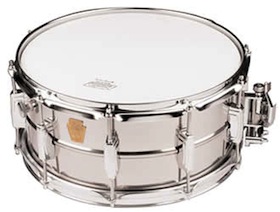
Bass Drum

Among the group of percussion instruments that make sound without a fixed pitch cymbals, triangle, tam-tam and snare drum, tenor drum and bass drum are commonly found in orchestras. Cymbals are concave metal plates. They are played by being struck with a variety of drum sticks, or by having a pair of cymbals clapped together. Usually they are used for emphasis. The triangle is simply a metal triangle held by a string. When struck by a metal stick it makes a bright tinkling sound. The tam-tam is a large, unpitched gong that is usually played with soft-headed sticks and has a low, muffled and suspenseful quality of sound. Although there are thousands of types of drums, orchestras tend to use only snare drums, tenor drums and the bass drum. These can be played with a variety of sticks and techniques to produce a wide array of percussive sounds. In the orchestra drums tend to emphasize certain climactic moments in the music and produce special effects such as suggesting martial music
String Family
String instruments produce sound by having taught strings that vibrate over a sound box, a hollow box with holes under the strings which contains trapped air that vibrates with the vibrations of the strings, thus amplifying the sound. The strings can be bowed (as is common with a violin), plucked (as is common with a guitar) or struck (as is common with a piano). Bows used with violins and other orchestral strings are made from very tightly strung horsehair attached to a wooden stick and coated with a substance called rosin that helps the bow grip the strings. The strings of plucked string instruments like the guitar often are played with picks, small, hard objects that strike the strings cleanly. Struck string instruments are played by hammers hitting the strings either mechanically as in the case of the piano or held in a player's hand as in the case of the dulcimer.
A pitch played on a string instrument is determined by the length of the string that vibrates freely when it is played. Orchestral string instruments exist in a family that contains small instruments, the violin, the highest in pitch; medium sized instruments, the viola, the tenor or next highest instrument; the moderately large instruments, the violoncello or cello, the baritone or medium low instrument; and the very large instruments, the double bass, the lowest instrument. Pitch is determined on each individual instrument by a player stopping or pressing on a string at a precise point, thus pinning it to the neck of the instrument, to shorten the length of the string. A sting that naturally vibrates at the pitch "e," then, when it is stopped by a player's finger at a certain point, will vibrate at, for example, the pitch "g" above the original "e." Modern orchestral strings have smooth necks. A player must learn exactly where to place his or her fingers on the strings in order to make clear pitches. Bowed string instruments from early eras had frets on the necks of the instruments like guitars have today. Players stopped the strings on these instruments by holding the string down against the fret bar with their fingers. Guitars, banjos, mandolins and other hand held plucked string instruments all have frets on their necks.
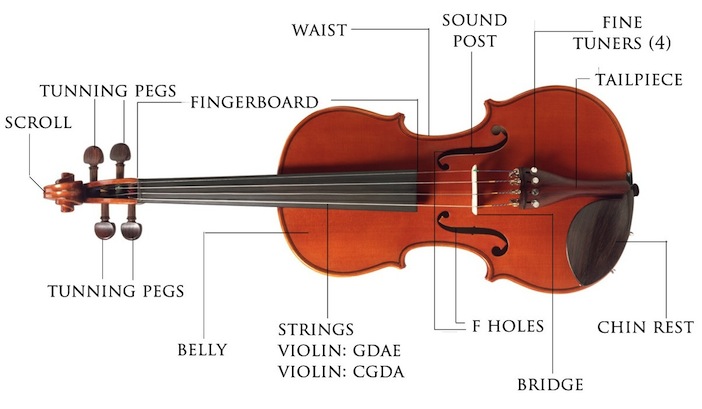
Violin
The sound of a violin is extremely versatile. It can be brilliant and it can be sweet and delicate. Its range spans both alto and soprano registers and its highest notes extend far higher than the vocal soprano range. It is useful in dramatic and virtuosic music as well as in simple song-like music. In an orchestra where relatively large groups of violins play together violins can produce strong, yet flexible tone and often are called on to play the melody of a piece.
Viola
The sound of a viola has a covered thick sound quality in its lower range, a quality that lends the instrument to excel at smooth accompaniments. The higher register is strong and intense. The viola is seldom used as a solo instrument.
The viola (bottom) is larger than a violin (top)
Cello
The cello, unlike the violin and viola, is played with the player sitting down and holding the instrument between his or her legs. The low register of the cello is rich and beautiful and the upper register is strong, penetrating, but still beautiful. The cello is a favorite solo instrument as well as an indispensable ensemble instrument.)
Contrabass
The double bass (also called bass, double bass, and bass viol) produces a wide, slightly foggy sound that sounds an octave lower than the music it plays. It is rarely used as a solo instrument, but is the foundation of an orchestra and a frequently heard instrument in jazz ensembles where it is almost always plucked.
Harp
The family of harps include large plucked string instruments that usually rest on the floor when played. Each string plays one pitch. A modern orchestral harp has 47 strings that extent for six and one-half octaves. A pedal mechanism allows the playing of chromatic pitches.
Keyboard and Electronic Instruments
The great advantage of keyboard instruments is that they can stand alone. They can play both harmony and melody at the same time. Therefore, more solo music has been written for keyboard instruments than for other instruments. The most important keyboard instruments in western music during the last 400 years are the clavichord, harpsichord, forte piano, piano (or piano forte), pipe organ, electronic keyboard and synthesizer. The clavichord, harpsichord and forte piano are primarily historical instruments. The clavichord was very popular among the upper classes in the late 16th and 17th Centuries. It is a relatively small box that could be placed on a table or a set of legs with a set of strings and a keyboard. The keys on the keyboard extend over a bar and under the strings. A metal piece at the end of the bar comes up and hits a string when the key is struck. The sound that is made is very soft (the instrument was used only in private rooms), but extremely sensitive and flexible. The harpsichord became very popular around 1600 and remained so for nearly 200 years. It is quite large, nearly the length of a moderate grand piano, but narrower, and contains an action so that when a player strikes a key, the key does not directly play a particular string. The harpsichord derived from plucked stringed instruments such as the lute, the archlute and theorbo. Sound from a harpsichord is actually made by plectra plucking the strings. When a key is struck the back end of the key rises and lifts a vertical bar that has a hook or plectrum attached to its side (this is similar to a guitar pick). The plectrum plucks the string next to it as it rises, then folds up as it falls back to its resting position. While harpsichords are designed to play relatively loudly, they could not produce expression. The plucking of the strings is always the same no matter how hard or soft the player strikes the key. However, to vary sounds harpsichords are designed with multiple keyboards and sets of strings that sound at different octaves and with mechanisms to soften the sound. The great change in the ability to create expression from keyboards came with the invention of the forte piano in the 18th Century. This instrument is similar to a modern piano. The instrument uses hammers to hit the strings rather than having the strings plucked by plectra as with the harpsichord. To facilitate this process it has an extensive action that allows a player to play any key both loudly and softly. Also, keys can respond to a player's touch and make sharp sounds as well as smooth, gentle sounds. In addition a pedal or damper mechanism allows strings to either stop sounding as soon as they are played or continue until the sound naturally dies out. Forte pianos can be played moderately loudly. The limiting factor to the degree of loudness they can produce is the fact that the frame of the instrument is made out of wood. This restricts the tension that can be placed on the strings, and, thus, limits the intensity with which the instrument can be played. Modern pianos are made with a metal case and steel hardware on which the strings are strung. The case surrounds a "sound board" which resonates with the vibrating strings and produces the piano's characteristic sound. Because the strings are attached to a metal frame they can be strung with extreme tension. This allows for the sound to project easily into large spaces. Beginning in the 19th Century this made the piano a favorite instrument for playing public concerts in large concert halls and as a solo instrument with orchestras.
Piano
The piano, the most common struck string instrument, makes sound when a hammer at the end of an elaborate series of levers called the action hits against a string. A player at the other end of the action sets the process in motion by pressing down on a key. The strings that are struck vibrate over a large, resonant slab of wood called the sound board, thus producing the characteristic sound of the instrument.
Pipe Organ

Pipe organs have a large number of sets of tuned pipes through which a complex wind system blows air. Air constantly flows through the system generated by an electronic blower (before the invention of electricity boys generally were employed to step on tread pedals to supply the air). When a key is played on a keyboard it opens a slide at the base of one or a set of pipes, allowing the air to flow through the pipe(s) and sound to be made. The pipes have different tone colors and different pitches. Large pipe organs can be capable of making a sound similar to a full orchestra. Most organs have more than one keyboard to control the different sets of pipes (stops) as well as a pedal board, which is played by the player's feet, to control the lowest sounding pipes. A moderately sized organ has 40 to 50 stops with many of them able to gradually get louder or softer. The largest organ, built at Atlantic City, New Jersey, has 33,112 pipes arranged in 1477 stops. Organs do not generally play with orchestras, though they are used in certain specific pieces.
Electronic Keyboards, Synthesizers, and Computers
Electronic keyboards include electronic organs, electronic keyboards (pianos), synthesizers and computers. Electronic keyboards sound vaguely like acoustic instruments and are far cheaper. Sound is recorded (sampled) or synthesized and then activated electronically when a key is hit. Keyboards can produce a wide variety of sounds. Computers can be programmed to play keyboard music. Players simply press a spot on the screen that often looks like a key to play a note. Again, the sound possibilities in using a computer are virtually endless.
The Orchestra
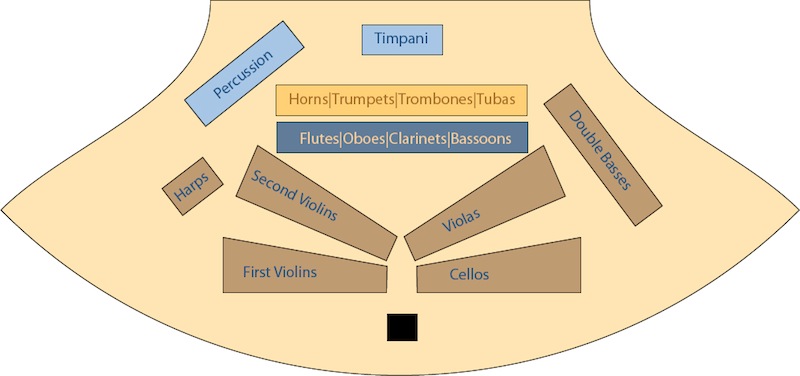
A Common Orchestra Seating Plan
The orchestra has been an evolving ensemble since its first appearance in the 1700s. It continues to remain a fluid group that reflects contemporary tastes in music. Typically modern orchestras are made up of 80 to 100 musicians. The ensemble is divided into sections or choirs based on the instrument groups previously discussed. The strings are the core of the ensemble. They account for the largest number of players and the fundamental sound of the orchestra. Woodwinds, brass and percussion with additional instruments as needed such as a piano or organ make up the remainder. Usually orchestras consist of 30 to 36 violins, twelve to fourteen violas, ten to sixteen cellos and six to ten double basses. Woodwinds usually include two flutes and a piccolo, two clarinets, two oboes and an English horn, two bassoons and a contrabassoon. The brass includes two to four trumpets, four French horns, two or three trombones and a tuba. The percussion includes all of the instruments listed previously. But, these are played intermittently and not all are used in any one piece. Usually one player plays the timpani and several others cover the remaining instruments.
The seating plan for an orchestra reflects the facts that the strings are the core of the orchestra and that balance and precision are extremely important in orchestral performance. Higher playing instruments and those that tend to play melody most often are near the front. Bass instruments, harmony playing instruments and loud instruments tend to be farther back. The conductor is placed in the center at the front of the group. Surrounding him or her are the strings. In most orchestras first violins are to the conductor's left with second violins next to them. Cellos are to the conductor's right with violas next to them. Double basses are behind the cellos and violas. In some orchestras, however, second violins and cellos are switched. Woodwinds are placed in the center facing out. Flutes and oboes usually are placed in front of clarinets and bassoons because they tend to sound higher. The brass choir is usually spread out across the back. Always, like instruments are placed together. Percussion and other large instruments such as harps and the piano are placed in the back behind the violins and woodwinds. Such a seating plan allows for the ensemble to play with a cohesive, unified sound and to play with extreme precision.





